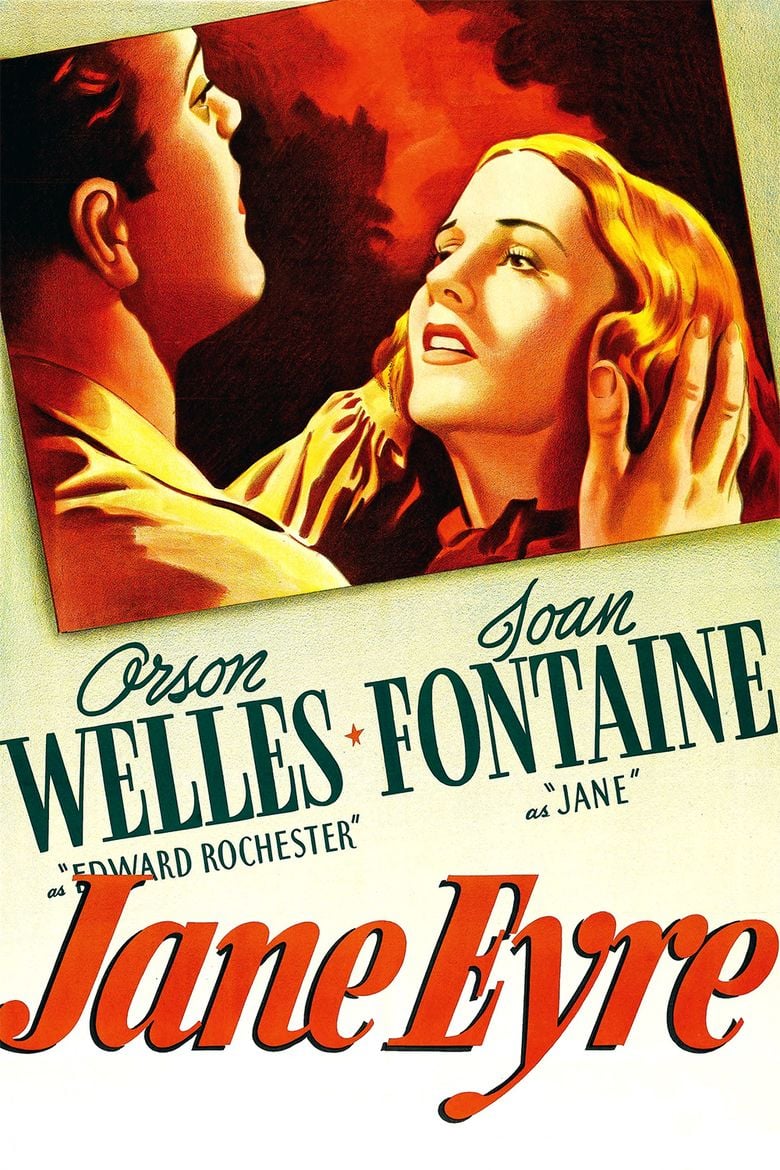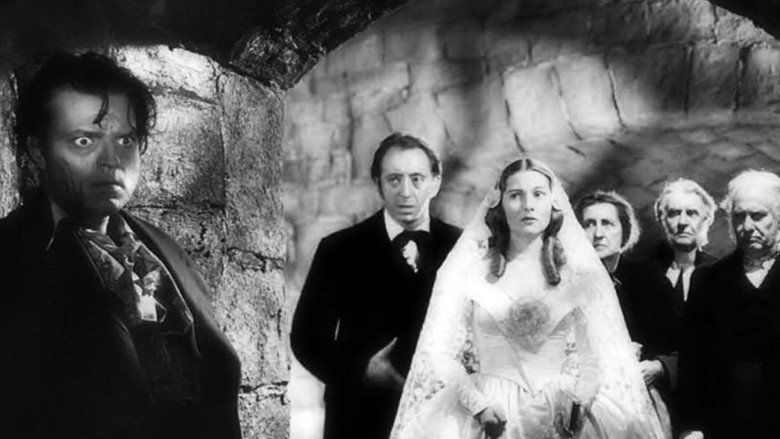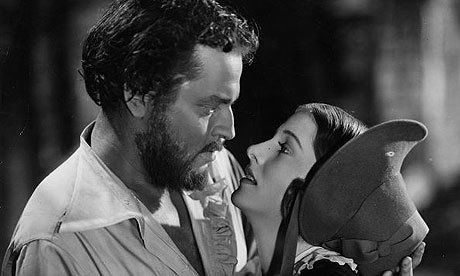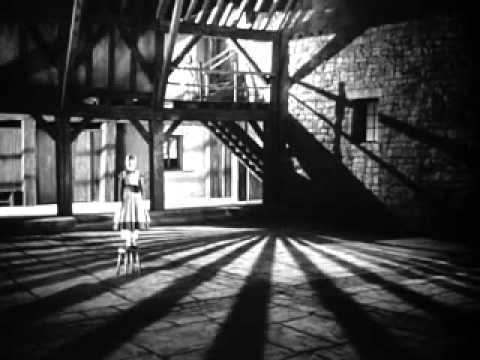Jane Eyre (1943 film)
7.8 /10 1 Votes
Genre Drama, Romance Duration Country United States | 7.6/10 IMDb Director Robert Stevenson Language English | |||||||||||||||||||||||||||||||||
 | ||||||||||||||||||||||||||||||||||
Release date December 24, 1943 (1943-12-24) (UK)February 4, 1944 (1944-02-04) (U.S.) Based on Jane Eyre1847 novel by Charlotte Bronte Cast (Edward Rochester), (Jane Eyre), (Adele Varens), (Jane Eyre (younger)), (Dr. Rivers), (Bessie) Similar movies Il Trovatore , Il Trovatore , Il Trovatore , Brooklyn , Amélie , There's Something About Mary | ||||||||||||||||||||||||||||||||||
Jane eyre 1943 trailer
Jane Eyre is an American film adaptation of Charlotte Brontë's 1847 novel of the same name, released by 20th Century Fox. It was directed by Robert Stevenson and produced by Kenneth Macgowan and Orson Welles, both uncredited. The film stars Welles and Joan Fontaine. Elizabeth Taylor made an early, uncredited appearance as Helen Burns.
Contents

The screenplay was written by John Houseman, Aldous Huxley and director Robert Stevenson. The music score was by Bernard Herrmann and the cinematography by George Barnes.

Plot

Orphaned, unloved, and unwanted ten-year-old Jane Eyre (Peggy Ann Garner) lives with her cruel, selfish, uncaring paternal aunt, Mrs. Reed (Agnes Moorehead) of Gateshead Hall. Jane is ecstatic when Mrs. Reed, eager to be rid of the child, arranges for Jane to be sent to Lowood Institution, a charity boarding school for young girls, run by the disciplinarian Reverend Brocklehurst (Henry Daniell).

Based on what Mrs. Reed has told him, Mr. Brocklehurst labels Jane a liar in front of her schoolmates and orders her to stand on a stool for hours on her first day of attendance. She is comforted and befriended by another student, Helen Burns (Elizabeth Taylor). Later, Jane protests when Brocklehurst orders that Helen's naturally curling hair be cut. Both are punished by being forced to walk circles in a courtyard during a downpour. Dr. Rivers (John Sutton), a sympathetic physician who periodically checks on the students, brings them inside, but it is too late for Helen, who dies that night.

Ten years later, in 1840, 20-year-old Jane (Joan Fontaine) turns down Brocklehurst's offer of a teaching position. She advertises for and accepts a job as governess for a young girl named Adèle (Margaret O'Brien). When she arrives at Thornfield, a gloomy, isolated mansion, she initially thinks her employer is Mrs. Fairfax (Edith Barrett), who is only the housekeeper for the absent master.

Jane goes for a walk one night, only to startle a horse into throwing and slightly injuring its rider, Edward Rochester (Orson Welles)—who she doesn't realize is her employer. When Jane arrives back at Thornfield, she discovers this fact, and Rochester calls her into his library to interview her.

That night, Jane is awakened by strange laughter. She investigates, and discovers that Mr. Rochester's bed curtains are on fire. She rouses the sleeping man and they extinguish the fire without rousing anyone. Rochester bids her wait while he goes to another wing of the house, where mysterious seamstress Grace Poole (an uncredited Ethel Griffies) keeps to herself. When he returns, he tells Jane nothing other than that the matter is under control. The next morning, he leaves Thornfield.
A winter and spring go by before he returns with a large group of guests. Jane is greatly saddened when Mrs. Fairfax discloses that everyone expects Rochester to marry Blanche Ingram (Hillary Brooke). However, Rochester confides to Jane his conviction that Miss Ingram is attracted only by his wealth.
When a man named Mason (an uncredited John Abbott) of Spanish Town, Jamaica, arrives at Thornfield, Jane sees that Rochester is disturbed. That night, a scream awakens everyone. Rochester assures his guests it is just a servant's reaction to a nightmare, but after he sends them back to their rooms, he has Jane secretly tend a bleeding Mason, while he fetches a doctor. Jane assumes Grace is responsible. Rochester has the doctor take Mason away.
Rochester has a private conversation with Blanche, in which he bluntly asserts that she is a gold digger. Offended, she and the guests leave. Unaware of this development, Jane broaches the topic of her future employment elsewhere after Rochester gets married. He reveals to Jane that he intends to marry her.
During the wedding ceremony, an attorney intervenes and declares that Rochester has a wife still living, who is mentally ill and deranged. This is confirmed by Mason, Rochester's brother-in-law. Rochester calls off the marital ceremony and takes them back to Thornfield to reveal his insane spouse, who lives in a tower cell, guarded by Grace Poole. Jane rejects Rochester's offer to stay together without being married. She departs Thornfield.
With her funds exhausted, Jane returns to Gateshead. She discovers that her aunt has suffered a stroke, caused by worry over the ruinous gambling habits of her son, who it is revealed has committed suicide. There is a reconciliation. After Mrs. Reed dies, Jane ponders what to do next, when she hears an anguished and beloved male voice from thin air calling her name.
Jane returns to Thornfield and finds it in ruins. Mrs. Fairfax informs her that the lunatic escaped, set the place on fire, and fled to the roof. When Rochester tried to rescue her, she jumped and was killed. He was blinded when the burning staircase collapsed underneath him. With no other impediments, Jane joyfully returns to him. She narrates that, when their son was born, her husband's vision was sufficiently restored for him to see their child.
Production
Jane Eyre was John Houseman's first assignment after he went to work for David O. Selznick in spring 1941. He started work on the screenplay during rehearsals for the Mercury Theatre's Broadway production of Native Son. Robert Stevenson, a British director Selznick had under contract, was sent to New York City to work with him. After the play's March 24 premiere, Houseman and Stevenson flew to the West Coast and completed the screenplay over the next five weeks. According to Houseman, Stevenson did most of the work. "We finished it and presented it to our leader, only to discover that he had not the slightest intention of producing it," Houseman wrote. Selznick executive Daniel O'Shea began to offer the production as a package that included the services of Stevenson as director, Joan Fontaine as star, architect William Pereira as production designer and George Barnes as cinematographer. The price was so "fabulous", Houseman wrote, that it took a year to find a buyer. In the midst of the war boom in November 1942, Selznick finally sold the package to William Goetz at 20th Century Fox, which Goetz was running in the absence of Darryl F. Zanuck.
Aldous Huxley also contributed to the screenplay, rendering the character of Mrs. Rochester unseen—assuring that she would be more menacing, and circumventing British censorship regulations on the depiction of madness. Other contributors to the script include DeWitt Bodeen and playwright Keith Winter.
Selznick had always wanted Orson Welles to play the role of Edward Rochester, but despaired of ever getting him because of his contract with RKO Pictures. When Welles was signed for Jane Eyre in December 1942, he was no longer with RKO, and was eager to earn money to purchase, develop and cut the footage he had shot for It's All True, an ill-fated project for the U.S. government for which he had received no payment. He hired himself out as an actor—the first of many times that Welles would support his own film projects by acting in more conventional films. Welles was also struggling to retain his place in Hollywood as a producer, and he negotiated a role as the associate producer of Jane Eyre as well as top billing. He was paid $100,000—the same amount he received for his multiple responsibilities in Citizen Kane.
Welles had already adapted Jane Eyre twice for radio. The Mercury Theatre on the Air broadcast of September 18, 1938, is lost because Welles used the acetate original to prepare the film and the recording was irreparably damaged. In early December 1942, Selznick wrote Goetz that he and Welles agreed on the importance of casting character actors who were new to motion pictures. He offered to be present at a casting meeting, and asked that Welles be there, as well—"because I know few people in the history of the business who have shown such a talent for exact casting, and for digging up new people." Mercury Theatre players from stage and radio who appear in Jane Eyre include Agnes Moorehead, Erskine Sanford, Eustace Wyatt and Edith Barrett; but the character roles generally went to familiar Hollywood performers, many of them with British stage credits.
Welles and Selznick persuaded 20th Century Fox to hire Bernard Herrmann to compose the score for Jane Eyre. When the film's producer, Kenneth Macgowan, asked Herrmann what work he had done before, the composer angrily replied, "Well, I never hearda you, either!" Herrmann based his score for Jane Eyre on the score he had written for "Rebecca" (December 9, 1938), the first episode of Welles's radio series, The Campbell Playhouse. Alfred Newman, head of the Fox music department, admired Herrmann's work for RKO and gave him the rare privilege of conducting his own score—the first of many that Herrmann wrote for the studio.
Jane Eyre was in production from February 3 until mid-April 1943. On April 8, The Hollywood Reporter noted that Welles would receive an onscreen credit as associate producer. In an April 17 memo to Goetz, which he blind-copied to Stevenson, Selznick protested that such a credit would be unfair to the director, "who pretty clearly took up the responsibility of producer where I left off."
You know as well as I do that Orson is such a personality that if he is credited as a producer, Stevenson's credit is likely to degenerate into something of a stooge status, as has occurred with Norman Foster on Journey into Fear—and, mind you, on Journey into Fear, Orson chose not even to have his own name appear in connection with the production …
Three months later, in a letter to 20th Century Fox, a Selznick attorney agreed to Welles receiving a producer credit if he wanted it:
We have only just learned that Mr. Welles did a great deal more producing on the picture than we had previously known. We have been informed by people from your studio that Mr. Welles worked on the sets, changes in the script, in casting, among other things, and that he had charge of the editing …
Although the associate producer credit was stated in his contract, Welles chose to waive it. "Certainly I did a lot more than a producer ought to, but Stevenson didn't mind that," he later said, adding that they got along very well on the picture. "And I don't want to take credit away from him, all of which he deserves." No producer credit appears on the screen or in the Screen Achievement Records Bulletin of the Academy of Motion Picture Arts and Sciences.
Release
Jane Eyre premiered in New York City February 4, 1944 and in Los Angeles six days later, February 10, 1944. Although the film had its British premiere in late December 1943, it bears a 1944 U.S. copyright in the screen credits and it is often considered a 1944 picture.
Accolades
The film is recognized by American Film Institute in these lists:
Home media
Special features theatrical trailer and production stills; audio commentary by Joseph McBride and Margaret O'Brien; audio commentary by Nick Redman, Steven C. Smith and Julie Kirgo; isolated music track; "Know Your Ally: Britain", directed by Robert Stevenson; "Locked in the Tower: The Men Behind Jane Eyre" (2006), written and directed by John Cork, with commentary by Scott McIsaac, Simon Callow, Bob Thomas, Hugh Stevenson, Venetia Stevenson and Ursula Henderson.
References
Jane Eyre (1943 film) WikipediaJane Eyre (1943 film) IMDb Jane Eyre (1943 film) themoviedb.org
